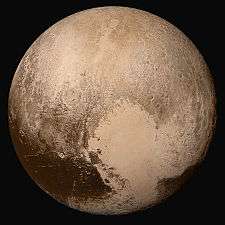Jovian–Plutonian gravitational effect


The Jovian–Plutonian gravitational effect is a hoax phenomenon stated to cause a noticeable short-term reduction in gravity on Earth that was invented for April Fools' Day by the English astronomer Patrick Moore and broadcast on BBC Radio 2 on 1 April 1976.
Background
Patrick Moore (4 March 1923 – 9 December 2012) was the doyen of British television astronomers, boasting a long career in public service broadcasting, a quick-fire manner of speech, and a number of eccentric habits, including the wearing of a monocle. A wartime navigator in the Royal Air Force's Bomber Command, he was elected a Fellow of the Royal Astronomical Society in 1945 and presented BBC Television's The Sky at Night programme from 1957 until his death. He was appointed an Officer of the Order of the British Empire in 1968. Above all, Moore had a high level of public recognition in the United Kingdom as a respected astronomer.[1]
The planet Jupiter is two and a half times as massive as all of the other planets in the Solar System combined.[2]
Pluto is so small and so remote from the Sun and the Earth that it was not discovered until 1930.[3] In 2006, the International Astronomical Union reclassified it as a dwarf planet, as it belongs to a belt of many similar small objects.[4]
Events of April 1976
On 1 April 1976, Moore stated to radio listeners that an astronomical event would take place at 9:47 a.m. that day, a conjunction of Jupiter and Pluto, which was expected to have an effect observable everywhere. As Pluto passed behind Jupiter, it would briefly cause a powerful combination of the two planets' gravitation which would noticeably decrease gravity on Earth. If listeners were to jump into the air at that exact moment, they would find they felt a floating sensation.[5][6]
Soon after 9:47 on that morning, the BBC began to receive hundreds of telephone calls from people reporting they had observed the decrease in gravity.[5] One woman who called in even stated that she and eleven friends had been sitting and had been "wafted from their chairs and orbited gently around the room".[7]
Hoax revealed
The story was quickly revealed as an April Fools' Day hoax. Martin Wainwright later wrote in The Guardian that Moore was "an ideal presenter" to carry off the hoax, with his weighty delivery having "an added air of batty enthusiasm that only added to his credibility".[7]
In 1980, Moore collaborated with Clyde Tombaugh, the man who had discovered Pluto in 1930, to publish a new book about the dwarf planet.[8]
Hoax explained
The hoax claims that the gravitational pull of Jupiter and Pluto combined will cause one to spend a significantly longer amount of time in the air due to an increase in gravitational pull from the distant planets; however, this is laughably incorrect. Although other planets do exert a gravitational pull on humans on Earth, the amount is incredibly small.
Although Jupiter is very massive, it is also very far away. When at its closest distance to Earth of about 600 million kilometers, Jupiter has a gravitational pull of 0.00013 newtons on a person with a mass of 100 kg, according to Newton's law of gravity. About 7.5 million times weaker than the Earth's gravity, this is roughly equivalent to the gravitational attraction of a compact car from half a meter away. Similarly, the gravitational pull of the dwarf planet Pluto on a person on Earth is roughly equal to that of a marble 100 meters away. Thus, the gravitational impact of the planets is far too small to be able to cause a person to weigh noticeably less, or stay in the air noticeably longer when jumping.
Popular Culture
The Jovian-Plutonian gravitational effect finds a subtle mention in the young-adult novel, All the Bright Places by Jennifer Niven. The effect is used to explain the gravitation-like chemistry that the male lead, Theodore Finch experiences towards the female character, Violet Markey. He characterizes this feeling as being weightlessly suspended in air, leaving all of their problems on earth while they stay afloat lighter together.[9]
See also
Notes
- ↑ Patrick Moore Biography online at hicelebs.com (accessed 27 March 2008)
- ↑ Beeb, Reta, Jupiter: The Giant Planet (Washington, D.C., Smithsonian Institution Press, 2nd edition, 1996, ISBN 1-56098-685-9)
- ↑ Tombaugh, Clyde W., The Search for the Ninth Planet, Pluto (Astronomical Society of the Pacific Leaflet No. 209, July 1946) reprinted in Mercury vol. 8, no. 1 (January/February 1979) pp 4-6
- ↑ "IAU 2006 General Assembly: Result of the IAU Resolution votes". International Astronomical Union. 2006. Retrieved 2008-01-26.
- 1 2 "Planetary Alignment Decreases Gravity -- April Fool's Day, 1976". Museum of Hoaxes. Retrieved 21 December 2013.
- ↑ Novak, Asami (24 March 2008). "10 Best: April Fools' Gags (the Web Is Closing for Spring Cleaning!)". Wired.
- 1 2 Wainright, Martin (30 March 2007). "Fooling around". The Guardian.
- ↑ Moore, Patrick, & Tombaugh, Clyde W., Out of the Darkness, the Planet Pluto (Harrisburg, Pa., Stackpole Books; and London, Lutterworth Press, 1980)
- ↑ "All the Bright Places"
References
- Tombaugh, Clyde W., Pluto in The Astronomy Encyclopaedia, ed. Patrick Moore (London, M. Beazley, 1987)
External links
- sirpatrickmoore.com - official site